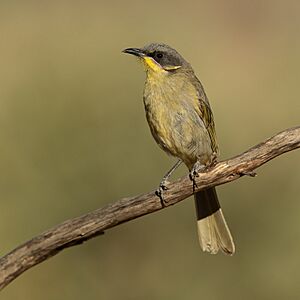Purple-gaped honeyeater facts for kids
Quick facts for kids Purple-gaped honeyeater |
|
|---|---|
 |
|
| Conservation status | |
| Scientific classification | |
| Genus: |
Lichenostomus
|
| Species: |
cratitius
|
| Subspecies | |
|
|
 |
|
| Distribution of the purple-gaped honeyeater | |
The purple-gaped honeyeater (scientific name: Lichenostomus cratitius) is a type of bird. It belongs to the Meliphagidae family, which includes many honeyeaters. This bird lives only in southern Australia. It prefers dry areas like mallee forests and tall heathlands. You can also find it in low eucalypt woodlands.
Contents
Meet the Purple-Gaped Honeyeater
The purple-gaped honeyeater is a medium-sized bird. It usually measures about 16 to 19 centimeters long. Its back is a grey-olive color. Its belly is a yellowish-buff color.
What Does It Look Like?
This bird has a unique head pattern. It has a black stripe near its eye. This stripe stands out against its grey head. Above its yellow throat streak, you'll see a purple area called a gape. It also has pointed yellow feathers covering its ears.
Younger birds look similar to adults. However, their face patterns are not as bright. Their feathers are a bit browner. They also have a yellow gape instead of purple. The honeyeaters living on Kangaroo Island are often bigger and darker.
You might confuse them with other birds. These include the yellow-plumed honeyeater and the singing honeyeater.
What Does It Sound Like?
The purple-gaped honeyeater has a clear song. It sounds like toweet-toweet-toweet. This is often followed by a high-pitched yep-yep-yep. They often sing from a tall tree branch. Sometimes, they even sing before the sun comes up!
Where Do Purple-Gaped Honeyeaters Live?
These birds live in different parts of southern Australia. You can find them from southern Western Australia to the east. The eastern groups mostly live south of the Murray River. New South Wales is the very edge of their northern range. Even though they live in separate areas, all purple-gaped honeyeaters are very similar genetically.
Life in the Wild: Habits and Habitat
Purple-gaped honeyeaters mainly live in mallee woodlands and shrublands. This includes areas with bull mallee trees. They also like patches of green mallee or blue mallee.
They can also be found in yellow gum woodlands. These areas often have thick bushes like 'totem-poles' or violet honey-myrtle. These bushes grow in low-lying areas and gullies within mallee regions.
Sometimes, they visit river red gums near waterways. They might also be seen in red ironbark woodlands when these trees are flowering. Occasionally, you might even spot them in gardens!
Social Life of Honeyeaters
These birds like to be with others. They are usually seen in pairs. Sometimes, you can find groups of 3 to 8 birds. They are generally quiet birds. But in spring, they can be quite noisy with their calls. They enjoy drinking and bathing often, especially when it's warm.
Purple-gaped honeyeaters often hang out with yellow-plumed honeyeaters and tawny-crowned honeyeaters. However, they can be a bit aggressive towards other honeyeaters. They often chase other birds, especially when they are eating.
What Do They Eat?
Purple-gaped honeyeaters mostly eat nectar and insects. They love to feed on flowering mallee eucalypts and banksias. They also look for insects under loose bark on tree trunks and branches. Sometimes, they even catch flying insects in the air. They less often eat seeds, pollen, or honeydew from scale insects.
Reproduction and Nests
Purple-gaped honeyeaters build small, cup-shaped nests. They use strips of bark, grass, and soft down. They hold the nest together with spider webs and egg sacs. The nest is usually placed in a horizontal fork of a branch. Or it might be in slender branches within thick leaves. They often choose broombush or eucalypt trees. Their nests are usually less than three meters above the ground.
Threats to Honeyeaters
The purple-gaped honeyeater is at risk when mallee forests are cleared. This destroys their homes. It removes the plants they need for food and nesting.
Protecting the Purple-Gaped Honeyeater
Many groups are working to protect these birds.
Conservation Status
- Around the World
- The IUCN Red List of Threatened Species lists this bird as a species of 'Least Concern'. This means it's not currently in great danger globally.
- In Australia
- In New South Wales, it is listed as Vulnerable. This is under the Biodiversity Conservation Act 2016.
- In South Australia, it is listed as Rare. This is under the National Parks and Wildlife Act 1972.
- In Victoria, it is listed as Vulnerable. This is under the Flora and Fauna Guarantee Act 1988.
Protected Areas Where They Live
Purple-gaped honeyeaters live in several protected areas. These places help keep them safe.
- New South Wales
- South Australia
- Victoria
- Greater Bendigo National Park
- Hattah-Kulkyne National Park
- Little Desert National Park
- Murray-Sunset National Park
- Wyperfeld National Park
- Big Desert Wilderness Park
- Lake Albacutya Park
- Inglewood Nature Conservation Reserve
- Wychitella Nature Conservation Reserve
- Western Australia


